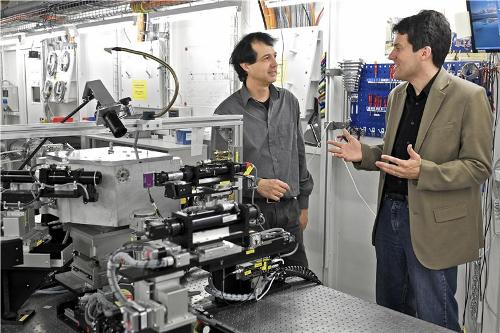Paul Scherrer Institute’s researchers have succeeded in accurately understanding how a material’s magnetic structure changes. The study was conducted using cupric oxide or CuO. First the material was subjected to a laser pulse, then short X-ray pulses helped obtain almost instantaneous images of several points in time for separate interim steps during the structure change process.
 Urs Staub (left) and Steven Johnson at the FEMTO beamline at SLS. (Paul Scherrer Institute/M. Fischer)
Urs Staub (left) and Steven Johnson at the FEMTO beamline at SLS. (Paul Scherrer Institute/M. Fischer)
It was observed that the material structure starts changing 400 fs after the striking of the laser pulse. The research also proves that X-ray lasers can be used for specific kinds of high-speed magnetic processes. The results will help develop innovative technologies in the coming days for magnetic storage media. The research has been published in the recent edition of the technical journal Physical Review Letters.
The researchers studied the magnetic orientation in CuO by conducting experiments at the LCLS facility, a free-electron X-ray laser in Stanford, California. Based on temperature, it has been observed that CuO showed totally distinct magnetic orientations. Below a temperature of -60°C, the spins that act like magnets in the copper atoms point in one direction for some time and then in the other. From a temperature of -60 to -43°C, the magnets are aligned in a helical manner similar to a spiral staircase. The experiment has clearly shown how much time is needed to switch from one alignment to the other, though the magnetic orientations were already discovered.
The spokesman for the PSI experiment, Steven Johnson stated that a cold sample was initially heated with a high-intensity optical laser flash. The sample was then illuminated with a very short X-ray laser pulse that enables to determine the structure. The experiment was conducted repeatedly with different time intervals between the X-ray pulse and the light flash enabling reconstruction of the change process of the sample’s structure.
According to the results, it takes 400 fs before there is a visible change in the magnetic structure. Then the structure changes to its final form. It was observed that speed at which the state changed was proportional to the light intensity.